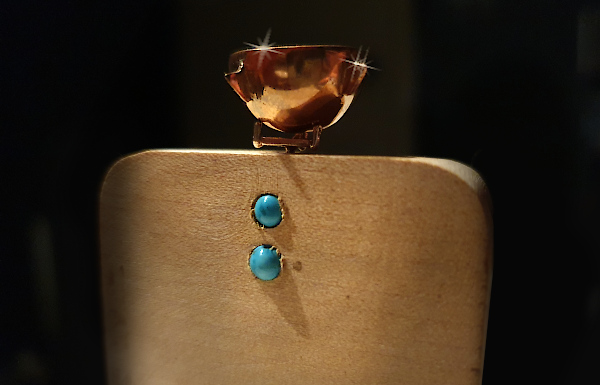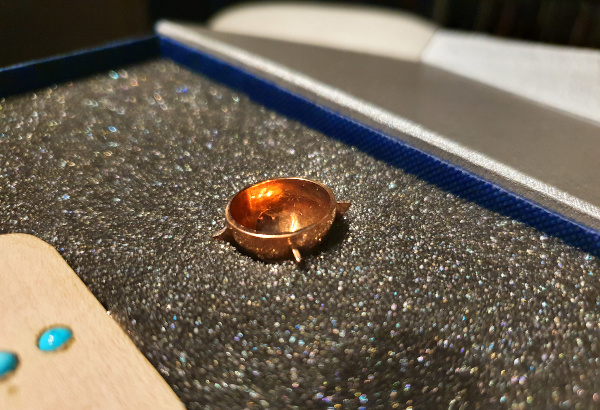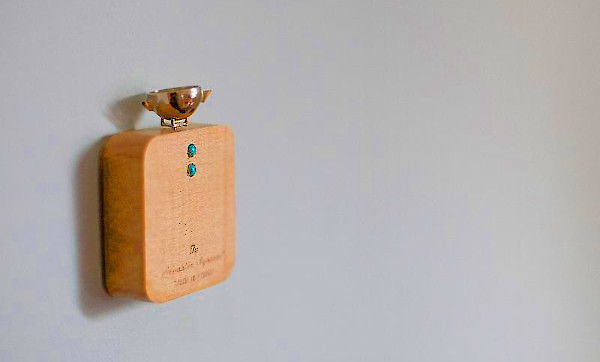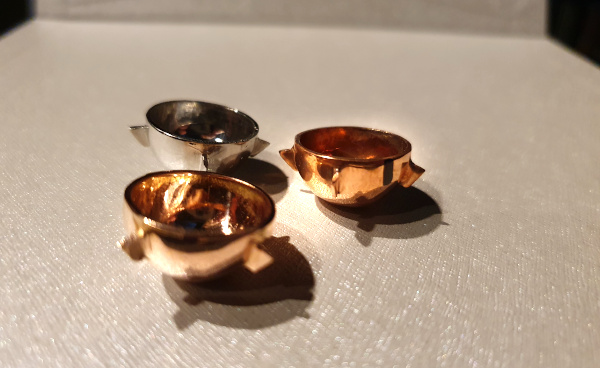ASI Resonators
After my spring hi-fi adventure with Acoustic System International’s Sugar Cubes, about which I enthusiastically reported in the article called ASI Sugar Cubes: Devil’s Dice, my autumn venture has become predestined. Unlike rather mysteriously but ultra-effectively functioning Sugar Cubes, the ASI Resonators follow the principles of physic: they resonate.

Angel bowls
ASI makes five types of the resonators. They differ by the material used for both the bowl and the base.
The Basic is an alloy of copper and silver, weighing 4.5g. It should provide “straight and fast” resonances, whatever it means.
The Silver is an alloy of silver and copper, weighing 5g. It should provide “light, open and airy” resonances.
The Gold is an alloy of gold, silver, and copper, weighing 7g. It should provide “rich” resonances.
The Gold Special is a pure gold one, weighing 6.5g. It should provide “rich and brilliant” resonances.
The Platinum is a platinum one, weighing 9g. It should provide “wide and open” resonances.
The wooden base block for Basic and Silver is soft maple, for the other three it is hard maple.
My approach to the Resonators was a matter of deliberate choices for I was not willing to remove or move existing Synergistic Research HFTs and ASI Sugar Cubes that resided on the walls. Not that it could not be done in less than 10 minutes, but because I spent over 9 months mapping the walls and fine-tuning their positions, then recalibrating and refining again. Especially the Sugar Cubes are a very powerful treatment to my home acoustics, and because they are very sensitive not only to placement as such but also to the azimuth and the direction of their openings, I did not want to lose what I had achieved. To illustrate the case: It has been 6 weeks ago when I sat down to listen to the music, and I did not like what I was hearing. I checked that every connector was in place, everything was connected properly, batteries were up and running… I checked everything in the system and could not resolve the issue. The sound was just not right. I was checking the speaker cables for maybe the third time when I noticed that one of the Sugar Cubes – the one that was attached to skirting right above the floor – was unattached and lied on the floor. It was not a dramatic displacement, the cube was 2 centimeters from its original position, but flipped. I moved it back and voilà – the great sound was back. So you understand that I was not going to touch any of the Sugar Cubes or HFTs.
The ASI Resonators were therefore used to complement existing treatment. This was a bit unfair to them and I would prefer to start a blank installation with them, but that was it. Anyway, the producer says that the Sugar Cubes and the Resonators are complementary, so ahead I went. After studying all the available literature and the manual (the local distributor provided it and I found it extremely useful) I got down to work. This text is the result of several weeks of experiments. I cannot stress high enough how much it is important to be patient. The difference between “I cannot hear a change” and “Wow!” is often just one centimeter away.
At the same time, I did not have the full resonator line-up on hand. After carefully evaluating the placement options I asked for 3x Platinum, 3x Gold Special and 1x Silver. As a bonus I received 1x Basic with a letter saying “You should try this as well as this is the first thing that should go between the speakers on the front wall”. OK, I started like that.

Front.
The manual recommends to place the Basic 15cm above the floor in the center of the front wall, and complement it with the Silver placed 30-60cm above the tweeter level, and another Silver placed 15cm below the ceiling, all centered between the speakers. I did not have 2 Silvers so I used the Platinum instead. It worked surprisingly well.
A small detour now. The winged bowls look symmetric, but they aren’t. In fact, only the Platinum resonator has all the wings symmetrically placed around its perimeter. On other versions the gap between one couple of the wings is narrower. The best way to spot it is when you look on the bowl placed upside down on a sheet of paper. When placed on its base tripod, the narrow gap should face the listener as this way it should provide better focus to sound. On the contrary, the wider gap between the wings should provide more ambience. The degree of tilting is another variable. Because the bowl is on the tripod, it is easy to let it fire upward or tilt it into one or another direction. The result will be highly individual, but it is worth spending some time with precise positioning.
I rely on Dee Dee Bridgewater and Christian McBride’s It´s Your Thing for getting the vertical soundstage right (Accuphase SACD-4 sampler). With improper placement of a resonator(s) Dee Dee drops down to the floor or – vice versa – is 3 meters tall. The Resonators on the front wall were like leading lights for the sound. When I moved the upper Silver resonator up and down, the voice followed it and the spatial perspective changed. For the Silver resonator was in the lateral center of the wall, it was mostly the phantom center that was affected and towards the wall’s edges the image was less affected. For instance, the McBride’s double bass, that is slightly off-center left, got very tall, and the McBride’s vocal, that left to the double bass, remained below it in the vertical perspective. As if he held the instrument above his head. With the narrow gap towards me the bass was punchier, with the wider gap it got more diffuse. With the proper placement I could get the right balance between the soundstaging acuity and focus. Was it an improvement versus the situation sans-resonators? Sure. Would I be willing to pay for such the improvement more than 100 euro? Not at all. Let’s move on.

Sides.
When I swapped the centered Silver for Gold Special the temperature of sound went up by a degree, transients got rounder, and bass got smeared. In my room, In my room. In my room. See, in your room it may be different. Where the Silver may be the option for one, the Gold or Gold Special may be the option for another. For me, the best option was the Platinum.
I removed all resonators from the front center positions and placed just one Platinum at the tweeter’s height. The sound improved massively. The double bass got more palpable and focused, the voices were more present and alive. This time it was clearly heard what the sound was like before, and what it was after.
When you move to the sides there are many options again. I liked how the resonators at ear level can open the room’s acoustic. It was as if the sound enveloped me, and the walls were moved much further apart. It was as if I was sitting in much bigger auditorium. I was not surprised, other resonating devices that I tested in my room worked this direction too. After all, they resonate and radiate the frequencies they are tuned to, so this delayed frequencies blend with the direct sound and create the illusion of enhanced space. Even more importantly, they are the harmonics of the resonator fundamental frequencies that overlay the direct sound and harmonize what we hear. The resonators are about adding, not subtracting.
I spent quite some time deciding whether the added resonances were what I wanted. After all it was a sonic patina that universally appeared on everything I played. I liked the effect of the music that is rich in effects, like Satriani’s Borg Sex (Joe Satriani, Engines of Creation, Epic SACD ES67860). Out of sudden I got absorbed by whirling synths that revolve around my head. When the ASI resonators were removed, the sound was less enveloping and as if more damped. On Pink Floyd’s The Dark Side of The Moon (Analogue Productions/Capitol CDP 7243 5821 36 2 1) Speak to Me starts with heart throbs that are deep in the soundstage, off-center right. The echo of the throbs, however, is panned left, coming seemingly from other room. Without the resonators the effect is there, but with them it is stunning, surround-like.
Recently I have reviewed Stephan Micus’ new excellent album Winter´s End (ECM, 2698 359 2771). It is sparsely instrumented music that gives a lot of room to each note. The ASI resonators supported the bloom and decay of each note, and the listening experience acquired holographic presence. The album is amazing, with the resonators it got amazing squared.

Outside the house.
Unlike both the ASI Sugar Cubes and the Synergistic Research HFT system the ASI Resonators are less comfortable to work with. The wooden bases are easy to stick to the walls with Blu-Tack (enclosed in the packaging). However, the bowl is quite heavy and torque force does the rest and the base detaches, especially if the walls are porous or the paint peels off. On glass or lacquer this is not an issue. Also, when balancing on a chair or ladder it is not easy to place the miniature bowl on its tripod, rotate it and tilt it. More than once I had to remove it as I had no clue where the narrow gap was facing. The distributor advices to mark the narrow gap with permanent marker – a good idea.
The ASI Resonators can easily employ you for many evenings. Franck Tchang, the creator of ASI, points out that you should stay open-minded and do not be afraid of trying seemingly nonsense placements. He likes mentioning the Platinum resonator placed on a tree in his garden behind the house, that improves the depth of soundfield. Although I am not sure whether it is a good idea to place platinum bowls on trees in my neighborhood, feel free to try it out and let me know.

Price: from 5200,- Kč per piece up.
Contact: Amarock Studio s.r.o., Kopřivnice, tel. +420 777 601 851
Manufacturer's website: https://asi-resonators.asi-resonators.com



